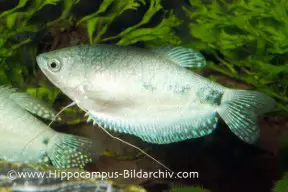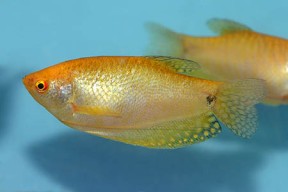Trichopodus trichopterus
Three-spot Gourami
Classification
Osphronemidae. Subfamily: Luciocephalinae
Distribution
Occurs mostly in the River Mekong basin in southern China, Vietnam, Laos, Cambodia, Thailand, Myanmar and Malaysia. It’s also found in parts of northern Indonesia. Has been introduced into numerous countries, including the Philippines, Taiwan, Papua New Guinea, the islands of Reunion, the Seychelles, Namibia, the Dominican Republic and Colombia. Don’t expect to find any wild specimens on sale, though. The vast majority of the ones in the hobby are commercially-bred in the Far East and Eastern Europe.
Habitat
Across its natural range it’s typically found in languid, heavily-vegetated, lowland waters including ponds, ditches, swamps and marshes. Around the central to lower Mekong many populations are known to migrate into flooded areas of forest or grassland during the wet season, returning to the main river systems when the floodwaters begin to recede.
Maximum Standard Length
6″ (15cm). Most aquarium specimens tend to remain a little smaller than this, but can still be expected to reach 5″ (12.5cm).
Aquarium SizeTop ↑
36″ x 12″ x 12″ (90x30x30cm)
Maintenance
A planted aquarium with some floating cover and open areas for swimming suits this species.
Water Conditions
Temperature: 75-86°C (24-30°C)
pH: 5.5-8.5
Hardness: 3-35 dH
Diet
Wild fish are fairly generalised omnivores, munching on both terrestrial and aquatic plants as well as algae, small invertebrates, other items of zooplankton and detritus. Unfussy and will accept most foods offered.
Behaviour and CompatibilityTop ↑
While often recommended as a community fish this is not always so. Some individuals can become very spiteful as they mature, while others remain peaceful. Males are territorial and will squabble amongst themselves, becoming very aggressive when breeding. It is best kept with robust fish such as barbs, larger characins, loricariids, loaches and other medium/large gouramis.
Sexual Dimorphism
The male is larger and develops a pointed dorsal fin. The female is smaller and rounder in the belly.
Reproduction
Easy. Bubblenester. The breeding tank should contain water of no more than 6-8″ in depth with lots of floating plants. Filtration should be gentle and air-powered filters are ideal. It is recommended to provide 2 or 3 females for the male as he can be quite hard on unwilling females. Condition the fish with live food. When a female becomes plump with eggs the male will construct a large bubblenest amongst the floating plants. He also utilises small pieces of plant within the nest. He will then begin to display to the female. As the female approaches the nest the fish can be seen touching each other with their modified ventral fins. Spawning occurs under the nest in the typical anabantoid embrace. The eggs float upwards and the male shepherds them into the nest. Several more spawnings occur and between 500-1200 eggs may be produced. When there are no more eggs the female is chased away. It is best to remove the female(s) at this point or she may be seriously harmed. The male then tends to the nest until the eggs hatch, usually in around 20-30 hours. The fry become free swimming in another 4-5 days, at which point the male should also be removed. They should be fed infusoria or liquid fry food for the first week, after which they are large enough to accept brine shrimp nauplii, microworm and powdered flake. The fry must be watched carefully and separated as different growth rates become apparent or much cannibalism will occur.
NotesTop ↑
This species is available in many different colour forms and varieties, all of which have been selectively bred for the aquarium trade. These are seen much more often than the natural form, which is the blue-grey three spotted fish. They include gold, opaline, cosby, marbled and silver forms. T. trichopterus is one of the hardiest fish commonly available in the trade and can adapt to many different water conditions. However it is recommended to the beginner with reservations regarding it’s temperament.










May 26th, 2014 at 12:55 am
I find that this species does best when kept 2 females per male. I find this eliminates aggression towards tank mates, and produces more interesting behavior. I have noticed when kept in groups of 2 females to 1 male, the dominant male will show intense colors and sometimes shoaling behavior can be observed.
January 30th, 2016 at 2:44 pm
I should never rekommend these gouramies in a tank that are smaller then 200l and i group of at least 5-6 individuals.
They are often pretty aggressive toward each other regardless of sex, i have had males who have been chased by females.
September 4th, 2019 at 9:51 pm
I have a pair of this species in an 80 cm aquarium, that were combined with pentazona barbs and kuhli loaches. Though the gouramis sometimes quarreled a bit with the other fish especially around feeding times, it mostly worked out fine… Until the gouramis started breeding that is, they defended their fry very agressively, relentlessly chasing the barbs around the tank and even killing a few of them. I was forced to relocate the surviving barbs to a different aquarium. Luckily the kuhli loaches stayed hidden well enough for the gouramis not to attack them. I would advice to be very careful when combining this species and probably a much larger tank is needed to ensure the safety of other fish during breeding time.